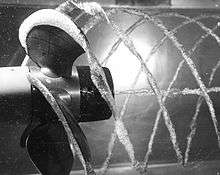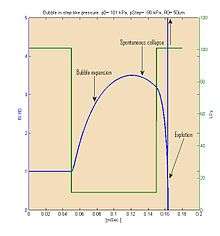Rayleigh–Plesset equation
In fluid mechanics, the Rayleigh–Plesset equation or Besant–Rayleigh–Plesset equation is an ordinary differential equation which governs the dynamics of a spherical bubble in an infinite body of incompressible fluid.[1][2][3][4] Its general form is usually written as

where
- is the density of the surrounding liquid, assumed to be constant
- is the radius of the bubble
- is the kinematic viscosity of the surrounding liquid, assumed to be constant
- is the surface tension of the bubble-liquid interface
- , in which, is the pressure within the bubble, assumed to be uniform and is the external pressure infinitely far from the bubble
Provided that is known and is given, the Rayleigh–Plesset equation can be used to solve for the time-varying bubble radius .
The Rayleigh–Plesset equation is derived from the Navier–Stokes equations under the assumption of spherical symmetry.[4]
History
Neglecting surface tension and viscosity, the equation was first derived by W. H. Besant in his 1859 book with the problem statement stated as An infinite mass of homogenous incompressible fluid acted upon by no forces is at rest, and a spherical portion of the fluid is suddenly annihilated; it is required to find the instantaneous alteration of pressure at any point of the mass, and the time in which the cavity will be filled up, the pressure at an infinite distance being supposed to remain constant (in fact, Besant attributes the problem to Cambridge Senate-House problems of 1847).[5] Neglecting the pressure variations inside the bubble, Besant predicted the time required to fill the cavity to be
where the integration was carried out by Lord Rayleigh in 1917, who derived the equation from energy balance. Rayleigh also realized that the assumption of constant pressure inside the cavity would become wrong as the radius decreases and he shows that using Boyle's law, if the radius of cavity decreases by a factor of , then the pressure near the boundary of the cavity becomes greater than the ambient pressure. The equation was first applied to traveling cavitation bubbles by Milton S. Plesset in 1949 by including effects of surface tension.[6]
Derivation


The Rayleigh–Plesset equation can be derived entirely from first principles using the bubble radius as the dynamic parameter.[3] Consider a spherical bubble with time-dependent radius , where is time. Assume that the bubble contains a homogeneously distributed vapor/gas with a uniform temperature and pressure . Outside the bubble is an infinite domain of liquid with constant density and dynamic viscosity . Let the temperature and pressure far from the bubble be and . The temperature is assumed to be constant. At a radial distance from the center of the bubble, the varying liquid properties are pressure , temperature , and radially outward velocity . Note that these liquid properties are only defined outside the bubble, for .
Mass conservation
By conservation of mass, the inverse-square law requires that the radially outward velocity must be inversely proportional to the square of the distance from the origin (the center of the bubble).[6] Therefore, letting be some function of time,
In the case of zero mass transport across the bubble surface, the velocity at the interface must be
which gives that
In the case where mass transport occurs, the rate of mass increase inside the bubble is given by
with being the volume of the bubble. If is the velocity of the liquid relative to the bubble at , then the mass entering the bubble is given by
with being the surface area of the bubble. Now by conservation of mass , therefore . Hence
Therefore
In many cases, the liquid density is much greater than the vapor density, , so that can be approximated by the original zero mass transfer form , so that[6]
Momentum conservation
Assuming that the liquid is a Newtonian fluid, the incompressible Navier–Stokes equation in spherical coordinates for motion in the radial direction gives
Substituting kinematic viscosity and rearranging gives
whereby substituting from mass conservation yields
Note that the viscous terms cancel during substitution.[6] Separating variables and integrating from the bubble boundary to gives
Boundary conditions
Let be the normal stress in the liquid that points radially outward from the center of the bubble. In spherical coordinates, for a fluid with constant density and constant viscosity,
Therefore at some small portion of the bubble surface, the net force per unit area acting on the lamina is
where is the surface tension.[6] If there is no mass transfer across the boundary, then this force per unit area must be zero, therefore
and so the result from momentum conservation becomes
whereby rearranging and letting gives the Rayleigh–Plesset equation[6]
Using dot notation to represent derivatives with respect to time, the Rayleigh–Plesset equation can be more succinctly written as
Solutions
Recently, analytical closed-form solutions were found for the Rayleigh–Plesset equation for both an empty and gas-filled bubble [7] and were generalized to the N-dimensional case.[8] The case when the surface tension is present due to the effects of capillarity were also studied.[8][9]
Also, for the special case where surface tension and viscosity are neglected, high-order analytical approximations are also known.[10]
In the static case, the Rayleigh–Plesset equation simplifies, yielding the Young-Laplace equation:
When only infinitesimal periodic variations in the bubble radius and pressure are considered, the RP equation also yields the expression of the natural frequency of the bubble oscillation.
References
- Rayleigh, Lord (1917). "On the pressure developed in a liquid during the collapse of a spherical cavity". Phil. Mag. 34 (200): 94–98. doi:10.1080/14786440808635681.
- Plesset, M.S. (1949). "The dynamics of cavitation bubbles". J. Appl. Mech. 16: 228–231.
- Leighton, T. G. (17 April 2007). "Derivation of the Rayleigh–Plesset equation in terms of volume". Southampton, UK: Institute of Sound and Vibration Research. Cite journal requires
|journal=(help) - Lin, Hao; Brian D. Storey; Andrew J. Szeri (2002). "Inertially driven inhomogeneities in violently collapsing bubbles: the validity of the Rayleigh–Plesset equation". Journal of Fluid Mechanics. 452 (1): 145–162. Bibcode:2002JFM...452..145L. doi:10.1017/S0022112001006693. ISSN 0022-1120.
- Besant, W. H. (1859). A treatise on hydrostatics and hydrodynamics. Deighton, Bell. Article. 158.
- Brennen, Christopher E. (1995). Cavitation and Bubble Dynamics. Oxford University Press. ISBN 978-0-19-509409-1.
- Kudryashov, Nikolay A.; Sinelshchikov, Dnitry I. (18 September 2014). "Analytical solutions of the Rayleigh equation for empty and gas-filled bubble". Journal of Physics A: Mathematical and Theoretical. 47 (40): 405202. arXiv:1409.6699. Bibcode:2014JPhA...47N5202K. doi:10.1088/1751-8113/47/40/405202.
- Kudryashov, Nikolay A.; Sinelshchikov, Dnitry I. (31 December 2014). "Analytical solutions for problems of bubble dynamics". Physics Letters A. 379 (8): 798–802. arXiv:1608.00811. Bibcode:2016arXiv160800811K. doi:10.1016/j.physleta.2014.12.049.
- Mancas, Stefan C.; Rosu, Haret C. (2016). "Cavitation of spherical bubbles: closed-form, parametric, and numerical solutions". Physics of Fluids. 28 (2): 022009. arXiv:1508.01157. Bibcode:2016PhFl...28b2009M. doi:10.1063/1.4942237.
- Obreschkow, D.; Bruderer M.; Farhat, M. (5 June 2012). "Analytical approximations for the collapse of an empty spherical bubble". Physical Review E. 85 (6): 066303. arXiv:1205.4202. Bibcode:2012PhRvE..85f6303O. doi:10.1103/PhysRevE.85.066303. PMID 23005202.